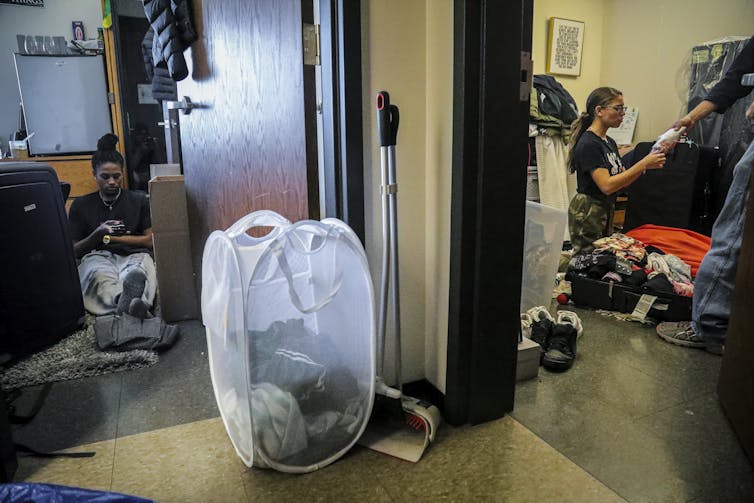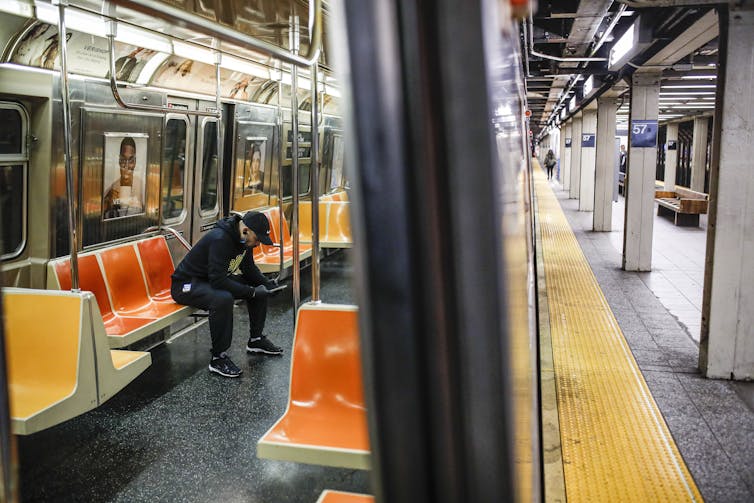Fleeing from the coronavirus is dangerous for you, the people you encounter along the way and wherever you end up
- Written by Rebecca S.B. Fischer, Assistant Professor of Epidemiology, Texas A&M University
COVID-19 is affecting life in nearly every corner of the globe. Public health officials are heavily relying on two community interventions to curb the pandemic spread: social distancing[1] and restricted travel[2]. Because these measures interrupt personal contact, they can be effective at preventing the spread of the coronavirus that causes COVID-19. But the guidelines and restrictions can be confusing, leave room for interpretation, and may even seem to contradict each other.
Colleges and universities across the globe are shutting down[3], potentially forcing many thousands of students to fly or drive home[4]. Large population centers like New York and even the entire state of California have been put under “shelter in place” restrictions[5] that ask people to stay home as much as possible. Despite this, some people are fleeing[6] to family, friends, second homes or even campsites in more rural areas. As an infectious disease epidemiologist[7], the idea of increased travel during a time when disease is spreading so rampantly scares me.
So how does travel, whether voluntary or compelled, fit into the mix of restrictions and guidelines being rolled out across the U.S.? And what impact does travel have on this pandemic?
 Students at many universities were given only a few days to pack up and leave.
AP Photo/Bebeto Matthews[8]
Students at many universities were given only a few days to pack up and leave.
AP Photo/Bebeto Matthews[8]
School closings and other forced travel
Shared facilities and close quarters at colleges - think dorms, dining halls and fitness centers - are havens for germs and facilitate the spread of diseaese[9]. Recent moves to cancel classes, close schools and shut down dormitories[10] are an attempt to promote social distancing and reduce the likelihood of community-based disease spread.
While closing high-risk areas like these during a pandemic is a proactive step to slow disease and protect students’ health, it may seem contradictory to another public health strategy: restricting travel. Displaced residents may need to find alternate housing or travel to stay with family or friends[11], and students have been crisscrossing the U.S. and the globe[12] over the last few weeks.
From an epidemiological perspective, there are two major concerns when it comes to travel. The first is that a traveler who is free of COVID-19 but forced to travel – presumably to escape potential exposure – actually faces an increased risk of becoming exposed to the coronavirus if it is circulating at the destination.
Secondly, an infected traveler is a moving transmission source. A sick traveler could expose others while in transit, such as in the airport[13] or while stopping for gas or food. They could also introduce the virus into previously unexposed communities. Since it’s proving so difficult to limit the spread of this virus once it hits a new place or population, as evidenced by the pandemic[14] itself, it is important to protect unexposed communities.
Take Houston, Texas, for example. The first cases were imported by travelers returning home[15] from abroad. Repeat importations of COVID-19 from other states in the U.S. ensued, and the virus eventually established itself in the city and began to spread locally.
The truth is that any degree of travel can facilitate both the interpersonal and geographic spread of disease, driving COVID-19 into more places and putting additional people at risk.
 New York City is eerily empty. Many people have fled the city as fear of the virus increased.
AP Photo/John Minchillo[16]
New York City is eerily empty. Many people have fled the city as fear of the virus increased.
AP Photo/John Minchillo[16]
Run to the hills or shelter in place?
For students kicked out of schools or tourists coming home from a trip abroad, travel may be unavoidable. But what if you just want to flee a major city and go somewhere with fewer people?
The same risks described above apply to voluntary travelers. The more time you spend in airports, gas stations and public restrooms, the higher your chances of being exposed to the coronavirus. There is also the risk that your destination is no safer than what you left behind.
Only people who have not been exposed to coronavirus should even consider traveling, and knowing whether you are infected or not is surprisingly difficult. On average, five to 10 days pass[17] between the moment of infection and when symptoms first start. To complicate matters, it seems somewhere between 20-50% of people with COVID-19 may never show symptoms at all[18], while 80% may have only mild signs[19], though these numbers may change as epidemiologists learn more about who is really infected.
If you are infected and don’t know it but still travel, you could be giving the coronavirus a free ride to your destination with many pit stops along the way.
How to travel safely
The safest way to travel right now is to not travel at all. The current advice is to shelter in place, and there are various restrictions[20] on domestic and international travel. These are changing quickly but are not likely to let up soon.
If you have the slightest reason to believe you have been exposed to SARS-CoV-2, even if you do not have symptoms, you have an ethical dilemma to consider before traveling. Your decision to travel could create unnecessary health risk to friends, family and others in your community, including people who may ultimately not recover from illness.
But if you must travel right now, do it as responsibly as possible. Follow all of the advice of the World Health Organization[21], and in the U.S., listen to the Centers for Disease Control and Prevention[22]. Strictly adhere to guidelines for hygiene, and heed medical advice if you are sick.
If you are doing everything in your power to protect yourself from infection, you are also doing some things that limit your potential spread of the virus, saving others from exposure.
[You need to understand the coronavirus pandemic, and we can help. Read our newsletter[23].]
References
- ^ social distancing (theconversation.com)
- ^ restricted travel (www.cdc.gov)
- ^ universities across the globe are shutting down (www.cnn.com)
- ^ thousands of students to fly or drive home (news.yahoo.com)
- ^ under “shelter in place” restrictions (www.theguardian.com)
- ^ some people are fleeing (www.mcall.com)
- ^ As an infectious disease epidemiologist (scholar.google.com)
- ^ AP Photo/Bebeto Matthews (www.apimages.com)
- ^ facilitate the spread of diseaese (www.menshealth.com)
- ^ cancel classes, close schools and shut down dormitories (www.usatoday.com)
- ^ find alternate housing or travel to stay with family or friends (www.teenvogue.com)
- ^ been crisscrossing the U.S. and the globe (www.jsonline.com)
- ^ could expose others while in transit, such as in the airport (www.webmd.com)
- ^ evidenced by the pandemic (www.nbcnewyork.com)
- ^ imported by travelers returning home (abc13.com)
- ^ AP Photo/John Minchillo (www.apimages.com)
- ^ five to 10 days pass (doi.org)
- ^ 20-50% of people with COVID-19 may never show symptoms at all (doi.org)
- ^ 80% may have only mild signs (weekly.chinacdc.cn)
- ^ there are various restrictions (www.who.int)
- ^ all of the advice of the World Health Organization (www.who.int)
- ^ in the U.S., listen to the Centers for Disease Control and Prevention (www.cdc.gov)
- ^ Read our newsletter (theconversation.com)
Authors: Rebecca S.B. Fischer, Assistant Professor of Epidemiology, Texas A&M University

